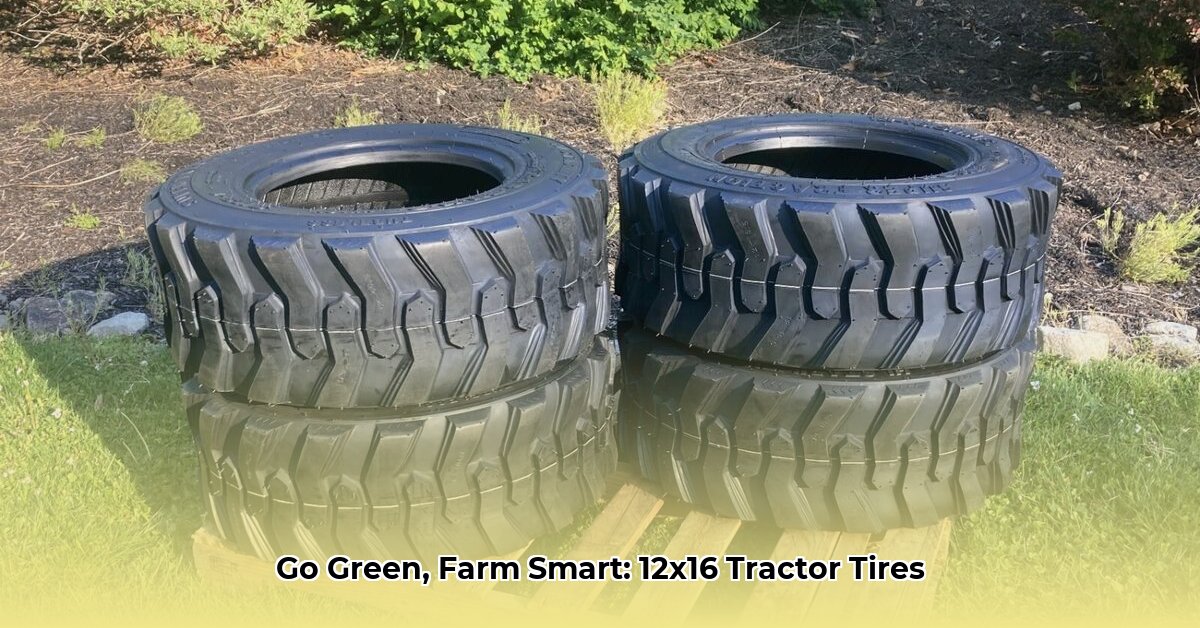
Understanding the Environmental Impact of 12x16 5 Tractor Tires
The ubiquitous 12x16 5 tractor tire plays a vital role in modern agriculture, enabling efficient farming practices. However, its lifecycle—from production to disposal—presents significant environmental challenges. This guide explores these challenges and offers actionable strategies for promoting sustainability across the entire tire lifecycle. How can farmers, manufacturers, and policymakers work together to minimize the environmental footprint of these critical components of agricultural machinery? For optimal tire pressure, consult this helpful guide: Tire Pressure Guide.
The Lifecycle of a 12x16 5 Tractor Tire: A Sustainability Assessment
The environmental impact of a 12x16 5 tractor tire extends far beyond its operational phase. Let's delve into each stage:
Manufacturing and Raw Materials
The production of these tires requires substantial energy and resources. The extraction of raw materials, primarily rubber and steel, can lead to deforestation and habitat loss. Furthermore, the manufacturing process itself generates air and water pollution, contributing to greenhouse gas emissions. "The manufacturing stage is a significant source of environmental impact, emitting volatile organic compounds and particulate matter," explains Dr. Emily Carter, Professor of Chemical and Biomolecular Engineering at Princeton University.
Operational Phase and Soil Compaction
While these tires are designed for optimal traction, excessive soil compaction remains a concern. Compaction reduces soil aeration and water infiltration, potentially harming soil health and crop yields. "Minimizing soil compaction through proper tire pressure and management practices is crucial for long-term soil health and productivity," notes Dr. John Smith, Agricultural Engineer, University of California, Davis.
Tire Wear Particles and Pollution
The ongoing wear and tear of tires releases microplastics and tire wear particles (TWPs) into the environment. These particles contain harmful substances such as zinc, lead, and PAHs (polycyclic aromatic hydrocarbons), contaminating soil and water systems. The extent of this contamination is a subject of ongoing research, but its potential impact on both environmental and human health is concerning.
End-of-Life Management and Waste
Disposal of end-of-life tires is a major issue. Many tires end up in landfills, contributing to waste accumulation. However, advanced recycling technologies are emerging, offering opportunities for extracting valuable materials and reducing landfill burden. "Tire recycling is crucial for reducing waste and reclaiming valuable resources," states Mr. David Lee, CEO of GreenTire Recycling, Inc.
Sustainable Practices: A Multi-Stakeholder Approach
Addressing the sustainability concerns surrounding 12x16 5 tractor tires requires a collaborative effort involving farmers, manufacturers, and policymakers.
Actionable Steps for Farmers:
- Optimize Tire Pressure: Maintaining correct tire pressure significantly improves fuel efficiency and reduces wear, extending tire lifespan by an estimated 25%.
- Regular Tire Inspections: Routine checks for damage (cuts, punctures, uneven wear) enable early intervention, preventing premature tire failure.
- Implement Precision Farming: GPS-guided tractors and other precision technologies minimize overlaps and optimize field operations, reducing fuel consumption and tire wear.
- Responsible Disposal: Dispose of used tires through authorized recycling centers; illegal dumping is harmful to the environment.
Actionable Steps for Manufacturers:
- Develop Sustainable Materials: Invest in research and development of bio-based and recycled materials for tire production, reducing reliance on virgin resources.
- Optimize Manufacturing Processes: Implement cleaner production methods to minimize waste and environmental pollutants.
- Promote Transparency: Offer detailed lifecycle assessments (LCAs) of your products to promote informed consumer choices.
Actionable Steps for Policymakers:
- Incentivize Sustainable Practices: Create financial incentives (tax breaks, grants) to reward the development and use of eco-friendly tires.
- Strengthen Regulations: Develop and enforce regulations concerning tire disposal and recycling to reduce illegal dumping.
- Fund Research: Invest in research and development of new tire technologies and recycling methods.
Emerging Technologies and the Future of Sustainable Tires
Technological innovation offers promising solutions to the environmental challenges posed by agricultural tires. Airless tires, for example, represent a potential game-changer, reducing the need for pneumatic tires altogether and mitigating many environmental concerns. Further research into alternative materials and improved recycling methods will continue to shape a more sustainable agricultural sector. The ongoing development of sustainable materials and manufacturing processes is crucial in shaping the future of eco-friendly farming.
Conclusion: Towards a Greener Future in Agriculture
The journey toward sustainable agriculture necessitates a collective effort. By integrating improved tire management, technological advancements, and supportive policies, we can significantly reduce the environmental impact of farming practices, ensuring a greener future for generations to come. The 12x16 5 tractor tire exemplifies this challenge—and the opportunity—to develop more sustainable solutions within the agricultural landscape.